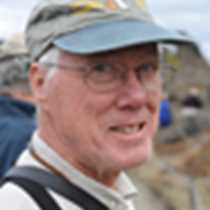The west side of the Antarctic Peninsula
The wind that chased us out of the Weddell Sea yesterday developed as predicted overnight. By morning we were headed down the west side of the Antarctic Peninsula, with Chief Officer Ben Lyons deftly maneuvering the National Geographic Explorer around pieces of ice, large (icebergs), medium (bergey-bits), and small (growlers). The west is the snowy side of the Peninsula. The mountains here intercept westerly winds blowing in from the Bellinghausen Sea, causing them to dump their moisture as snow. As snow accumulates it is compressed into ice, so glaciers line the straits and waterways that lead us further south. Chunks of ice calved from the glaciers make navigation interesting, indeed.
Our progress to the south was interrupted by an encounter with a humpback whale, only recently returned from his (or her) winter spent in the warmer waters of the Pacific Ocean. Humpback whales that were photographed in these very waters have been photographed again in the water off Costa Rica, thus demonstrating trans-equatorial migration, a contribution to science from a ship (our ship, I am proud to say) carrying tourists to Antarctica. Our morning whale showed no concern over our presence. It was too busy feeding, making repeated short and shallow dives seeking the krill that it needs to rebuild a layer of energy-rich blubber to see it through the coming winter in the north. It even left a conspicuous mark in the water to verify that it was feeding on (red) krill.
And on we went, passing through the narrow, scenic Errera Channel and into Andvord Bay for an afternoon landing at Neko Harbor. Here, we stepped off the Zodiac and onto the Antarctic continent, itself. For many, it was the elusive seventh continent and certainly the least often visited. We shared the landing with gentoo penguins nesting on exposed rock outcrops surrounded by the snow. Many of us trekked up the steep slope to a lookout point with an impressive vista over Neko Harbor and Andvord Bay, and across the Gerlache Strait to Anvers Island. Some then took the exhilarating slide back down again. Other of our corps of travelers joined Elise and Paula, our scientists from the Oceanites project, for an exercise in penguin counting. It isn't as easy as it might look. The count for the colony - nearly 1,300 nests - is down from the total of previous years. This is probably a result of heavy spring snowfall that prevented the birds' access to their nest sites. Penguins are rather long-lived birds. They will survive to nest another year.




